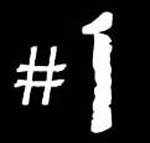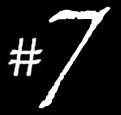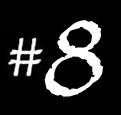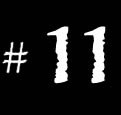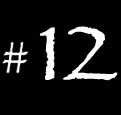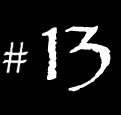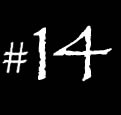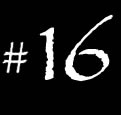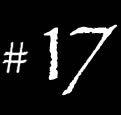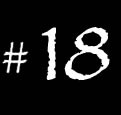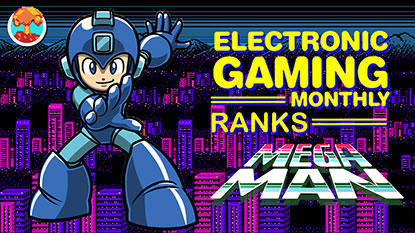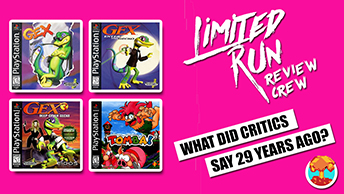- CLASSIC MAGAZINES
- REVIEW CREW
A show recapping what critics thought back
when classic games first came out! - NEXT GENERATION'S BEST & WORST
From the worst 1-star reviews to the best
5-stars can offer, this is Next Generation! - NINTENDO POWER (ARCHIVE)
Experience a variety of shows looking at the
often baffling history of Nintendo Power! - MAGAZINE RETROSPECTIVE
We're looking at the absolutely true history of
some of the most iconic game magazines ever! - SUPER PLAY'S TOP 600
The longest and most ambitious Super NES
countdown on the internet! - THEY SAID WHAT?
Debunking predictions and gossip found
in classic video game magazines! - NEXT GENERATION UNCOVERED
Cyril is back in this spin-off series, featuring the
cover critic review the art of Next Generation! - HARDCORE GAMER MAGAZING (PDF ISSUES)
Download all 36 issues of Hardcore Gamer
Magazine and relive the fun in PDF form!
- REVIEW CREW
- ELECTRONIC GAMING MONTHLY
- ELECTRONIC GAMING MONTHLY RANKS
From Mario to Sonic to Street Fighter, EGM
ranks classic game franchises and consoles! - ELECTRONIC GAMING MONTHLY BEST & WORST
Counting down EGM’s best and worst reviews
going year by year, from 1989 – 2009! - ELECTRONIC GAMING BEST & WORST AWARDS
11-part video series chronicling the ups and
downs of EGM’s Best & Worst Awards!
- ELECTRONIC GAMING MONTHLY RANKS
- GAME HISTORY
- GAME OVER: STORY BREAKDOWNS
Long-running series breaking down game
stories and analyzing their endings! - A BRIEF HISTORY OF GAMING w/ [NAME HERE]
Real history presented in a fun and pithy
format from a variety of game historians! - THE BLACK SHEEP
A series looking back at the black sheep
entries in popular game franchises! - INSTANT EXPERT
Everything you could possibly want to know
about a wide variety of gaming topics! - FREEZE FRAME
When something familiar happens in the games
industry, we're there to take a picture! - I'VE GOT YOUR NUMBER
Learn real video game history through a series
of number-themed episodes, starting at zero! - GREAT MOMENTS IN BAD ACTING
A joyous celebration of some of gaming's
absolute worst voice acting!
- GAME OVER: STORY BREAKDOWNS
- POPULAR SHOWS
- DG NEWS w/ LORNE RISELEY
Newsman Lorne Riseley hosts a regular
series looking at the hottest gaming news! - REVIEW REWIND
Cyril replays a game he reviewed 10+ years
ago to see if he got it right or wrong! - ON-RUNNING FEUDS
Defunct Games' longest-running show, with
editorials, observations and other fun oddities! - DEFUNCT GAMES QUIZ (ARCHIVE)
From online quizzes to game shows, we're
putting your video game knowledge to the test!- QUIZ: ONLINE PASS
Take a weekly quiz to see how well you know
the news and current gaming events! - QUIZ: KNOW THE GAME
One-on-one quiz show where contestants
find out if they actually know classic games! - QUIZ: THE LEADERBOARD
Can you guess the game based on the classic
review? Find out with The Leaderboard!
- QUIZ: ONLINE PASS
- DEFUNCT GAMES VS.
Cyril and the Defunct Games staff isn't afraid
to choose their favorite games and more! - CYRIL READS WORLDS OF POWER
Defunct Games recreates classic game
novelizations through the audio book format!
- DG NEWS w/ LORNE RISELEY
- COMEDY
- GAME EXPECTANCY
How long will your favorite hero live? We crunch
the numbers in this series about dying! - VIDEO GAME ADVICE
Famous game characters answer real personal
advice questions with a humorous slant! - FAKE GAMES: GUERILLA SCRAPBOOK
A long-running series about fake games and
the people who love them (covers included)! - WORST GAME EVER
A contest that attempts to create the worst
video game ever made, complete with covers! - LEVEL 1 STORIES
Literature based on the first stages of some
of your favorite classic video games! - THE COVER CRITIC
One of Defunct Games' earliest shows, Cover
Critic digs up some of the worst box art ever! - COMMERCIAL BREAK
Take a trip through some of the best and
worst video game advertisements of all time! - COMIC BOOK MODS
You've never seen comics like this before.
A curious mix of rewritten video game comics!
- GAME EXPECTANCY
- SERIES ARCHIVE
- NINTENDO SWITCH ONLINE ARCHIVE
A regularly-updated list of every Nintendo
Switch Online release, plus links to review! - PLAYSTATION PLUS CLASSIC ARCHIVE
A comprehensive list of every PlayStation
Plus classic release, including links! - RETRO-BIT PUBLISHING ARCHIVE
A regularly-updated list of every Retro-Bit
game released! - REVIEW MARATHONS w/ ADAM WALLACE
Join critic Adam Wallace as he takes us on a
classic review marathon with different themes!- DEFUNCT GAMES GOLF CLUB
Adam Wallace takes to the links to slice his way
through 72 classic golf game reviews! - 007 IN PIXELS
Adam Wallace takes on the world's greatest spy
as he reviews 15 weeks of James Bond games! - A SALUTE TO VAMPIRES
Adam Wallace is sinking his teeth into a series
covering Castlevania, BloodRayne and more! - CAPCOM'S CURSE
Adam Wallace is celebrating 13 days of Halloween
with a line-up of Capcom's scariest games! - THE FALL OF SUPERMAN
Adam Wallace is a man of steel for playing
some of the absolute worst Superman games! - THE 31 GAMES OF HALLOWEEN
Adam Wallace spends every day of October afraid
as he reviews some of the scariest games ever! - 12 WEEKS OF STAR TREK
Adam Wallace boldly goes where no critic has
gone before in this Star Trek marathon!
- DEFUNCT GAMES GOLF CLUB
- DAYS OF CHRISTMAS (ARCHIVE)
Annual holiday series with themed-episodes
that date all the way back to 2001!- 2015: 30 Ridiculous Retro Rumors
- 2014: 29 Magazines of Christmas
- 2013: 29 Questionable Power-Ups of Christmas
- 2012: 34 Theme Songs of Christmas
- 2011: 32 Game Endings of Christmas
- 2010: 31 Bonus Levels of Christmas
- 2009: 30 Genres of Christmas
- 2008: 29 Controls of Christmas
- 2007: 34 Cliches of Christmas
- 2006: 33 Consoles of Christmas
- 2005: 32 Articles of Christmas
- 2004: 31 Websites of Christmas
- 2003: 29 Issues of Christmas
- 2002: 28 Years of Christmas
- 2001: 33 Days of Christmas
- NINTENDO SWITCH ONLINE ARCHIVE
- REVIEW ARCHIVE
- FULL ARCHIVE
Defunct Games Golf Club: 18 Holes of Golf Round 2
Welcome back to the Defunct Games Golf Club. Adam Wallace has returned to the links to slice his way through another 18 classic golf games. Experience nearly 40 years of interactive golf as we play through games on the Odyssey 2, Atari 2600, Nintendo Entertainment System, Sega Master System, Genesis, Super NES, PlayStation 2 and more. It's the most exciting set of golf games yet, and you can join in every Friday between April 28 and August 25. That's 18 straight weeks of games based on the game of kings. Fore!

Hello, again, and welcome to Round 2 of the Defunct Games Golf Club. Just like last year, I will be reviewing 18 golf games on 18 different consoles. As I mentioned last year, the reasons I chose to review golf games (aside from golf being one of my favorite game genres) are two-fold. First, real golf can be problematic to play. Equipment is very expensive if you want to play well, green fees can be pricey even on public courses, weather is always a factor, and an average game can take two hours for just nine holes. Second, golf has a distinct advantage over many other sports in video game form. While sports like football or baseball are shackled by their strict set-ups and rules, limiting fantasy concepts, golf video games are open enough in their set-ups to allow many crazy ideas. [READ FULL REVIEW]

The Atari 2600 had one of the longest lifespans in video game history. Releasing in 1977, the 2600 wasn't officially discontinued until 1992, around the same time that the 7800 got canned. Even though Nintendo and Sega were ruling the game market with an iron fist by that point, new games for the 2600 continued to trickle into stores, especially outside the U.S. In cases like that, other countries got the better deal. Just as European Sega Master System owners got to enjoy Golfamania, Aussies who hadn't given up on the VCS got to enjoy My Golf. It was the last official second-gen golf game (not counting homebrews), and it blows away the original 2600 Golf in every way.
The list of ways My Golf improves upon the earlier game is almost a mile long. Unlike the nine basic holes the original game provided, My Golf provides a full eighteen hole course. [READ FULL REVIEW]

Grabbing licenses in the early days of video games was like playing dodgeball. Everyone wants to grab one first just to peg the opponent with it. While Atari was smacking around Mattel with all the arcade licenses they were snapping up, Mattel was beating Atari senseless with all the sports licenses they were getting. While the Intellivision didn't have official players or teams in their licensed sports games, the licenses looked good on the game cartridges and lended extra credibility to their titles. Not that Mattel needed the extra cred; one comparison between Football on the 2600 and NFL Football on Intellivision said everything. The same holds true when comparing PGA Golf to Golf on the 2600.
Mattel had every right to brag. Despite releasing around the same time, PGA Golf was miles ahead of its Atari competitor. [READ FULL REVIEW]

Standards changed dramatically when the NES came on the scene. The kinds of things that were excusable during the second generation just didn't fly anymore. That was definitely seen with golf games. Just providing an 18-hole digital golf course was no longer enough. In fact, if any third-gen golf game wanted to get away with having only one course on the cartridge, it had to do at least one of two things. It either had to provide an absolute doozy of a course that's a joy to play, or it had to provide enough modes and options to justify returning to the same course again and again. Unfortunately, Bandai Golf didn't come anywhere close to those marks.
If there's one thing I have to credit, it's the ambition. Bandai Golf: Challenge Pebble Beach was one of the first attempts to recreate a real golf course in digital form. [READ FULL REVIEW]

Okay, let's talk about one of the greatest misnomers in video game history (pun fully intended). Anyone who had a Sega Master System growing up was painfully aware of the "Great" sports line exclusive to the system which was anything but great. In fact, Defunct Games had already crucified Great Baseball and Great Ice Hockey, and don't expect better from Great Football or Great Basketball. However, as the saying goes, "Even a broken clock is right twice a day." Sega had to get at least one sport right, and it so happened to be when they took on golf.
Great Golf was the first golf game I got into when I was a kid; yes, this game is the reason I'm doing all these golf reviews now. Playing it again thirty years later, I can safely say it holds up in some ways and flops in others. [READ FULL REVIEW]

Ports from other sources always tended to be hit-or-miss. Normally this phenomenon would show up in the MANY attempts to port from the arcade. However, there have been plenty of cases of poor ports from the PC. I've always been a console gamer first and foremost, but I can name plenty of cases where console ports came nowhere close to the quality of the PC originals like the ports of Wolfenstein and Doom on the Super Nintendo. Regrettably, I have to add the Atari 7800's only traditional golf game Mean 18 to that list.
Mean 18 Ultimate Golf was originally released on the Amiga, the Atari ST computer line, and DOS. The Atari 7800 was the only console that got it although the developers made Jack Nicklaus' Turbo Golf as well (which I reviewed last year). [READ FULL REVIEW]
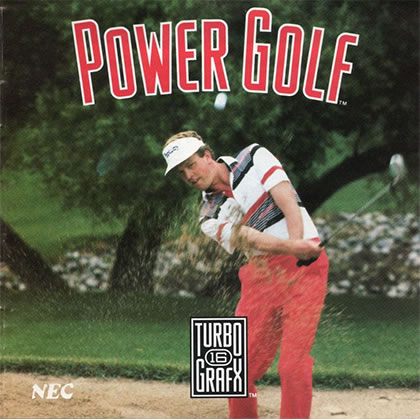
Where is the line between honest and unfair challenge? At what point does a game's difficulty get to the point where it's no longer worth trying to beat it? I guess it depends on the player. Some look at, say, Dark Souls and see a test of gaming skill that they will enjoy overcoming no matter how many times they get beaten down. Others see the same game as a cheap, unfair piece of crap designed to test how aerodynamic a controller can be when thrown at a wall. Needless to say, I had to ask those questions critically when looking at Power Golf. [READ FULL REVIEW]

2016 was a celebrity bloodbath. It seemed like every other day another famous person died. While actors like Carrie Fisher and Debbie Reynolds and singers like Prince and David Bowie got the lion's share of the headlines, 2016 also claimed the golf legend Arnold Palmer. As I said before, he, Jack Nicklaus, and Tiger Woods were the holy trinity of pro golf. Winning 62 PGA Tour titles from 1955 to 1973, including winning the Green Jacket from the Masters four times, and being one of the first inductees into the World Golf Hall of Fame certainly are enough to grant Palmer the nickname "The King". The only thing that surprises me is that Arnold Palmer only endorsed one golf game. Fortunately, Arnold Palmer Tournament Golf is a fantastic one. [READ FULL REVIEW]

Anyone who has paid attention to golf games for any length of time knows the name T&E Soft. Now known as D Wonderland, T&E Soft had been developing golf games since the Famicom era (when they weren't making the horrendous Hydlide games). They did both realistic and fantasy golf games and weren't afraid to experiment, as shown by their work on True Swing Golf on the DS and Golf on the Virtual Boy. Suffice to say, they know what they're doing. That doesn't mean the results wouldn't piss me off on occasion. Consider Wicked 18. [READ FULL REVIEW]

Golf on the portable consoles is always a crap shoot. With the limited consoles, the limited power, and especially the limited screen area, golf games on portable consoles can be quite easy to screw up. Last year I covered one that got it right (Awesome Golf on the Atari Lynx) and one that made some screw-ups (Fred Couples Golf on the Game Gear). Pocket Golf largely falls into the latter camp.
This Japanese release came from Bottom Up, the same company that provided the Dreamcast's only golf game Tee Off, and you can see a couple ... [READ FULL REVIEW]

There are often major discrepancies between the home console and portable versions of the same game. Usually the convenience of being able to take a game with you anywhere requires compromising somewhat on the gameplay and options for a game. It is almost unheard of for the portable version of a game to be better than the home console version, but that ended up being the case for the Game Gear version of Putt & Putter.
As one could guess from the title, Putt & Putter is a mini-golf game. Defunct Games looked at the Sega Master System version years ago and rated it slightly below average ... [READ FULL REVIEW]

The Game Boy Advance was the first major upgrade from the original Game Boy; no, I don't count the Game Boy Color. When it launched, there was the need to show off how much more advanced (excuse the pun) it was over the original gray bricks. As I mentioned when I reviewed Twisted Metal, launch titles tend to prioritize showing off the tech over being great games on their own. It becomes an even bigger crap-shoot when a company decides to experiment at the same time. [READ FULL REVIEW]

Those who had been keeping up with the Defunct Games Golf Club remember the very high score I gave PGA Tour Golf 3 for the Genesis. EA was definitely on their "A" game at that point with all their sports games but experienced growing pains when moving to the fifth generation. Their effort with PGA Tour 97 on the Saturn was very apparent, but they had a ways to go before they'd get back to their comfort zone.
PGA Tour 97 did a lot right. While it was disappointing that this entry reduced the number of courses on the disc to two, the two that made it in were great choices. Spyglass Hill and TPC Sawgrass are both challenging courses and well-rendered in the game. The visuals hold up very well for a twenty-year-old game with smooth textures and great camera work. There were some cheats used ... [READ FULL REVIEW]

As I mentioned when I reviewed Mary Shelley's Frankenstein on Sega CD, Psygnosis was a company that could always be trusted to squeeze every last drop out of a piece of hardware, and the Playstation was where they showcased some of their most graphically amazing work. The WipeOut and Colony Wars games still look impressive even today as do games like Chronicles of the Sword and Psybadek. Unfortunately, while their games almost always looked amazing, the gameplay tended to be much more hit-and-miss. Their only attempt at golf Pro 18 World Tour Golf was definitely a miss. [READ FULL REVIEW]

As I mentioned before, any golf game from third gen onward that tries to get away with only offering one course must do something truly special to justify it. Either the one course it offers has to be a blast to play, or it has to offer enough bonus modes and goodies to justify returning to the same course. T&E Soft definitely knew how to do those things. Wicked 18 provided a course that, while frustratingly difficult, had a hypnotic quality that could appeal to pros. Golf on the Virtual Boy took advantage of that system's capabilities to give players the feeling that they were really on the links (if they were Cyclops from the X-Men, that is). That's why Waialae Country Club infuriates me; because I know T&E Soft can do much better than this. [READ FULL REVIEW]

It's hard to be the new kid in town. Aksys Games has only existed for little more than a decade, but they gained a solid following thanks to games like the Zero Escape trilogy, Deathsmiles, and especially the Guilty Gear and BlazBlue series. With all those smashes under their belts, would anyone ever suspect that they began with a golf game? Eagle Eye Golf was the first game Aksys released, and though it got little attention at the time due to the release of the Playstation 3, it proved to be a sign of the greatness to come. For the most part, at least.
Eagle Eye Golf appears to be very generic on the surface. The stock character models are blocky, have little personality, and have terribly stilted voices. [READ FULL REVIEW]

When Hot Shots Golf became a major hit for the Playstation (a rarity for a golf game at the time), Nintendo did the prudent thing. They grabbed the developer Camelot to do the same thing for the Nintendo 64. The resulting Mario Golf was one of the best games overall on the system, let alone the best golf game. While the Hot Shots Golf franchise got turned over to Clap Handz for future installments, Camelot stayed with Nintendo to make the follow-up. Mario Golf: Toadstool Tour was the result, and it's the apex of the whole franchise.
Toadstool Tour has so many options that it's ridiculous. There are sixteen characters to choose from, each with natural tendencies to fade or draw in addition to the usual power and control balances. [READ FULL REVIEW]

Well, we've reached the final hole for Round 2 of the Defunct Games Golf Club. Once again, thank you all for joining me on this marathon of golf, and I look forward to starting up Round 3. After looking at the oldest, weirdest, best, and worst games to be associated with golf, I decided to wrap up Round 2 with a look at my absolute favorite golf game. No question about it, Outlaw Golf 2 on the Xbox is the one golf game I will always come back to despite all the other excellent games in the genre.
The first thing that should grab your attention is the "M" rating. On a golf game? Seriously? No, Outlaw Golf 2 doesn't do the stupid crap that BMX XXX did just for shock value. [READ FULL REVIEW]
#1: Golf (Atari 2600)
#2: Chip Shot: Super Pro Golf (Intellivision)
#3: Lee Trevino's Fighting Golf (NES)
#4: Golfmania (Master System)
#5: Ninja Golf (Atari 7800)
#6: Itchy & Scratchy in Miniature Golf Madness (Game Boy)
#7: Awesome Golf (Lynx)
#8: Fred Couples Golf (Game Gear)
#9: Jack Nicklaus: Turbo Golf (TurboGrafx-16)
#10: PGA Tour Golf III (Genesis)
#11: Links: The Challenge of Golf (Sega CD)
#12: 36 Great Holes Starring Fred Couples (32X)
#13: Kirby's Dream Course (Super NES)
#14: Neo Turf Masters (Neo Geo)
#15: VR Golf '97 (Saturn)
#16: Hot Shots Golf (PlayStation)
#17: CyberTiger (Nintendo 64)
#18: Tee Off (Dreamcast)
Tune in every Friday between April 28 and August 25 for new episodes of the Defunct Games Golf Club Round 2.
#2: Chip Shot: Super Pro Golf (Intellivision)
#3: Lee Trevino's Fighting Golf (NES)
#4: Golfmania (Master System)
#5: Ninja Golf (Atari 7800)
#6: Itchy & Scratchy in Miniature Golf Madness (Game Boy)
#7: Awesome Golf (Lynx)
#8: Fred Couples Golf (Game Gear)
#9: Jack Nicklaus: Turbo Golf (TurboGrafx-16)
#10: PGA Tour Golf III (Genesis)
#11: Links: The Challenge of Golf (Sega CD)
#12: 36 Great Holes Starring Fred Couples (32X)
#13: Kirby's Dream Course (Super NES)
#14: Neo Turf Masters (Neo Geo)
#15: VR Golf '97 (Saturn)
#16: Hot Shots Golf (PlayStation)
#17: CyberTiger (Nintendo 64)
#18: Tee Off (Dreamcast)
HOME |
CONTACT |
NOW HIRING |
WHAT IS DEFUNCT GAMES? |
NINTENDO SWITCH ONLINE |
RETRO-BIT PUBLISHING
Retro-Bit |
Switch Planet |
The Halcyon Show |
Same Name, Different Game |
Dragnix |
Press the Buttons
Game Zone Online | Hardcore Gamer | The Dreamcast Junkyard | Video Game Blogger
Dr Strife | Games For Lunch | Mondo Cool Cast | Boxed Pixels | Sega CD Universe | Gaming Trend
Game Zone Online | Hardcore Gamer | The Dreamcast Junkyard | Video Game Blogger
Dr Strife | Games For Lunch | Mondo Cool Cast | Boxed Pixels | Sega CD Universe | Gaming Trend
Copyright © 2001-2025 Defunct Games
All rights reserved. All trademarks are properties of their respective owners.
All rights reserved. All trademarks are properties of their respective owners.







